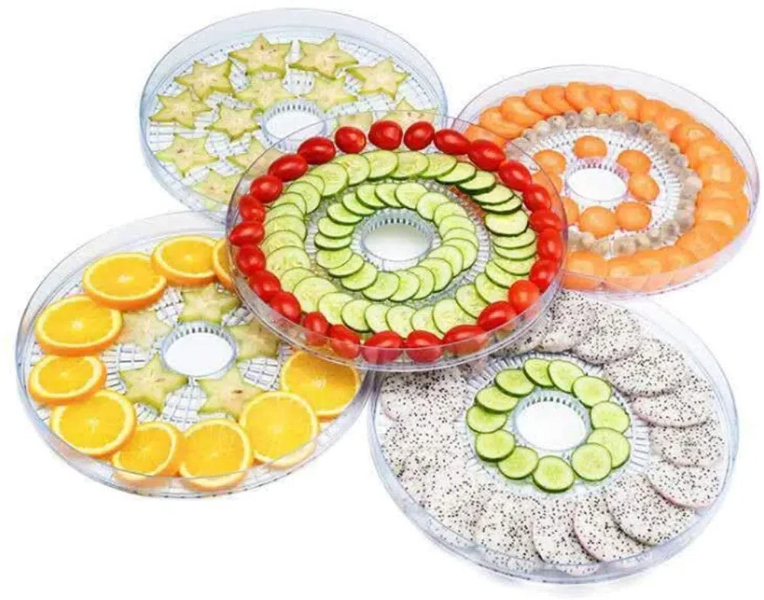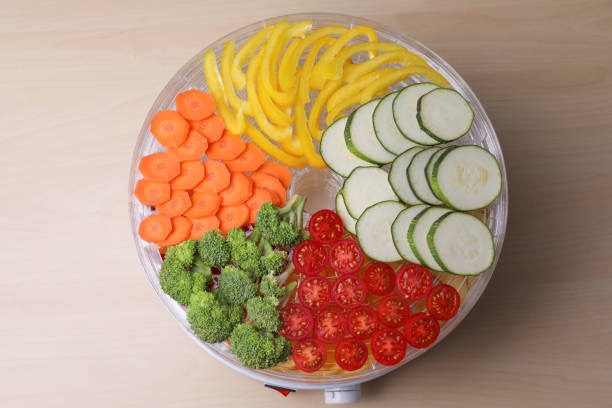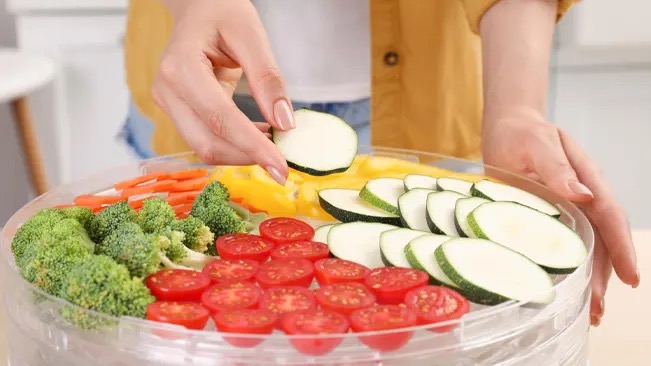
Content Menu
● Introduction
● Benefits of Cabinet Type Dehydrators
● Preparing Food for Dehydration
>> Slicing and Dicing
>> Blanching
>> Pre-Treatment
● Optimizing Dehydrator Settings
>> Temperature
>> Airflow
>> Humidity
>> Advanced Settings and Features
● Maximizing Energy Efficiency
>> Batch Processing
>> Full Loads
>> Strategic Timing
>> Temperature Adjustment
>> Timer Usage
>> Insulation Strategies
● Monitoring the Drying Process
>> Visual Inspection
>> Moisture Content Checks
>> Record Keeping
● Maintaining Your Cabinet Type Dehydrator
>> Regular Cleaning
>> Inspections
>> Component Replacement
>> Seal Integrity
>> Calibration
● Troubleshooting Common Issues
>> Uneven Drying
>> Scorching
>> Mold Growth
>> Extended Drying Times
● Applications of Cabinet Type Dehydrators
● Innovations in Cabinet Type Dehydrator Technology
>> Smart Dehydrators
>> Energy-Efficient Designs
>> Enhanced Airflow Systems
>> Integrated Monitoring and Control Systems
● Conclusion
● FAQ
>> 1. What is a cabinet type dehydrator?
>> 2. What are the benefits of using a cabinet type dehydrator?
>> 3. How do I improve the energy efficiency of my cabinet type dehydrator?
>> 4. What types of food can I dehydrate in a cabinet dehydrator?
>> 5. How often should I clean and maintain my cabinet dehydrator?
● Citations:
Introduction
As a Chinese food dehydrator manufacturing factory, we understand the critical role these machines play in the food processing industry. Cabinet type dehydrators, also known as shelf-style dehydrators, are essential for brands, wholesalers, and producers looking to extend the shelf life of food products while preserving their natural flavors and nutrients. This comprehensive guide provides best practices for using your cabinet type dehydrator effectively, optimizing its performance, and maximizing its benefits.
Cabinet dehydrators are self-contained units designed to remove moisture from food products. Their integrated design combines a heat pump dryer with a precisely controlled chamber to ensure consistent and efficient drying. Unlike simpler dehydrators, cabinet models offer unparalleled control and are ideal for commercial applications and serious home users.

Benefits of Cabinet Type Dehydrators
- Integrated Design: Optimizes performance and energy utilization by seamlessly integrating the heat pump dryer with the chamber. This design minimizes heat loss and maximizes airflow efficiency, ensuring uniform drying across all trays.
- Precise Control: Offers precise temperature and airflow control, ensuring even dehydration and preserving the integrity of textures and flavors. Accurate temperature settings are crucial for preventing scorching or under-drying of food products.
- Large Capacity: Suitable for processing significant quantities of food, making it ideal for commercial operations. They can handle batches ranging from 100kg to 1000kg of products. This large capacity allows businesses to efficiently process bulk quantities of produce, reducing labor costs and increasing throughput.
- Versatility: Can be used for various types of food products, from fruits and vegetables to meats, herbs, flowers, noodles, and pasta. Adjustable settings allow for optimized dehydration of different materials.
- Energy Efficiency: Optimizes energy use by integrating a heat pump dryer and minimizing heat loss through insulation. Modern cabinet dehydrators often feature insulated walls and doors to minimize heat loss.
- Extended Shelf Life: By effectively removing moisture, cabinet dehydrators significantly increase the shelf life of food products. Proper dehydration can extend the shelf life of food by months or even years, reducing spoilage and waste.
- Nutrient Preservation: Excels at preserving the natural flavors, colors, and nutrients in food. The precisely controlled drying process minimizes nutrient degradation, resulting in healthier and more flavorful products.
- Waste Reduction: Helps farmers and producers convert seasonal harvests into all-season products, minimizing food waste.
- Hygienic Environment: The enclosed design minimizes contamination from dust, insects, and other environmental factors, providing a hygienic environment for food processing.
Preparing Food for Dehydration
Proper food preparation is essential for efficient dehydration. The way you prepare your food directly impacts the quality of the final product and the efficiency of the dehydration process.
Slicing and Dicing
Cut food into uniform sizes and shapes to ensure even drying. Thinner slices dehydrate faster. For instance, apple slices should be about ¼ inch thick for optimal drying. Uniformity ensures that all pieces dry at the same rate, preventing some pieces from being over-dried while others remain moist. Different produce will benefit from different cuts, such as matchstick cuts for carrots, or rings for peppers.
Blanching
Blanching vegetables before dehydration can help preserve color and nutrients. Blanching involves briefly immersing vegetables in boiling water or steam, which inactivates enzymes that can cause discoloration and nutrient loss. This step is particularly important for vegetables like green beans, carrots, and broccoli. It's also essential for destroying harmful microorganisms. For optimal blanching, ensure that vegetables are submerged fully, and use an ice bath afterwards to halt the cooking process.
Pre-Treatment
Some fruits benefit from pre-treatment to prevent oxidation and maintain their color. For example, apples, pears, and peaches can be dipped in a solution of lemon juice and water or ascorbic acid (vitamin C) to prevent browning. Other effective treatments include honey dips and fruit juice soaks, which not only prevent oxidation but also enhance flavor. Consider the flavor profile you want to achieve when choosing a pre-treatment method.

Optimizing Dehydrator Settings
Temperature
Different foods require different temperatures for optimal dehydration. Use the following as a general guideline:
- Fruits: 130°F to 140°F (54°C to 60°C)
- Vegetables: 120°F to 130°F (49°C to 54°C)
- Meats: 145°F to 160°F (63°C to 71°C)
- Herbs: 95°F to 115°F (35°C to 46°C)
Accurate temperature settings are crucial for preventing scorching or under-drying of food products. Always consult the manufacturer's instructions or a reliable dehydration guide for specific recommendations. For meats, maintaining a high enough temperature is crucial to avoid bacterial growth. For herbs, a lower temperature helps preserve their volatile oils, which contribute to their flavor and aroma.
Airflow
Ensure that the dehydrator has a good airflow system and that food is spread evenly on the trays to ensure even drying. Avoid overcrowding. Proper airflow is essential for removing moisture effectively and ensuring uniform drying. If your dehydrator has adjustable airflow settings, experiment to find the optimal setting for different types of food.
Humidity
Monitor the humidity inside the dehydrator, especially when drying large batches of food. Some advanced dehydrators have humidity control settings that can be adjusted to optimize the drying process. High humidity can slow down the drying process and promote mold growth, while low humidity can cause the food to dry too quickly on the surface, trapping moisture inside.
Advanced Settings and Features
Modern cabinet dehydrators often come with advanced settings such as multi-stage drying programs, which allow you to set different temperatures and airflow rates for different stages of the drying process. This can be particularly useful for foods that require a gradual drying process. Look for features like automatic shut-off, digital displays, and programmable settings to enhance your dehydration process.
Maximizing Energy Efficiency
Batch Processing
Process multiple batches to minimize dehydrator heating and save electricity and time. It takes energy to get the dehydrator up to temperature, so running consecutive batches maximizes this initial energy input. Plan your dehydration schedule to take advantage of batch processing, and consider preparing multiple types of food at once to optimize energy usage.
Full Loads
Operate the dehydrator with full loads whenever possible to maximize energy efficiency. A fully loaded dehydrator utilizes the available space and energy more efficiently than a partially loaded one. However, avoid overcrowding, as this can impede airflow and lead to uneven drying.
Strategic Timing
Use the dehydrator during off-peak hours to take advantage of lower electricity rates. Many utility companies offer lower electricity rates during off-peak hours, typically at night. Check with your local utility provider for specific rates and schedules.
Temperature Adjustment
Tweak the heat as you go; start higher and then lower it for the end. This can help speed up the initial drying process and then reduce the risk of scorching as the food becomes drier. This technique is especially useful for thicker cuts of meat and fruit.
Timer Usage
Use a timer feature to avoid overdoing and wasting energy. A timer ensures that the dehydrator shuts off automatically when the food is properly dried, preventing unnecessary energy consumption. Some dehydrators come with smart features that allow you to control the timer remotely via a mobile app.
Insulation Strategies
Ensure the dehydrator is located in a well-insulated area to minimize heat loss. Avoid placing it near drafts or in cold rooms. You can also insulate the dehydrator further by placing blankets or insulated panels around it, but be careful not to block the airflow vents.
Monitoring the Drying Process
Visual Inspection
Regularly inspect the food for signs of drying, such as shrinkage, color change, and leathery texture. Visual inspection is one of the most reliable ways to determine if the food is properly dried.
Moisture Content Checks
Test the moisture content by squeezing or bending the food. It should feel dry and pliable, but not brittle. Use a food thermometer to check the internal temperature. For safety, meat should reach an internal temperature of 160°F (71°C) before dehydration. You can purchase moisture meters specifically designed for food dehydration to ensure accurate readings.
Record Keeping
Keep a log of your dehydration projects, noting the type of food, preparation methods, temperature settings, drying time, and final moisture content. This will help you refine your techniques and achieve consistent results in the future.
Maintaining Your Cabinet Type Dehydrator
Regular Cleaning
Clean your cabinet dehydrator after each use to prevent buildup and maintain hygiene. Regular cleaning prevents the accumulation of food particles and bacteria, ensuring a safe and hygienic food processing environment.
Inspections
Regularly inspect the dehydrator for any signs of wear and tear. Check for loose connections, damaged wires, and other potential issues. Early detection of potential problems can prevent costly repairs and downtime.
Component Replacement
Replace worn or damaged components promptly to prevent performance issues. This includes the heating element, fan motor, and control panel. Keep a supply of common replacement parts on hand to minimize downtime.
Seal Integrity
Check the door seal regularly. A damaged seal can allow warm, moist air to escape, reducing efficiency and prolonging drying times. Clean the seal regularly to remove any debris that may compromise its integrity.
[Include a video demonstrating how to properly clean and maintain a cabinet type dehydrator]
Calibration
Periodically calibrate the dehydrator's temperature and humidity sensors to ensure accurate readings. This is particularly important for commercial operations where precise control is essential.
Troubleshooting Common Issues
Uneven Drying
If you notice that some pieces of food are drying faster than others, it could be due to uneven slicing or overcrowding on the trays. Ensure that all pieces are uniformly sliced and that the trays are not overcrowded. Rotate the trays periodically to promote even drying. Additionally, check for hotspots within the dehydrator.
Scorching
Scorching can occur if the temperature is too high or if the food is placed too close to the heating element. Lower the temperature and ensure that there is adequate airflow around the food. Check the accuracy of your dehydrator's temperature settings, as a faulty thermostat can cause scorching.
Mold Growth
Mold growth indicates that the food was not properly dried or that the dehydrator was not clean. Discard any moldy food and thoroughly clean the dehydrator before using it again. Ensure that food is dried to a moisture content low enough to prevent mold growth. Proper storage of dehydrated foods is also crucial for preventing mold.
Extended Drying Times
Extended drying times can be caused by high humidity, low temperature settings, or overcrowding. Adjust the settings accordingly and ensure that the dehydrator is operating in a well-ventilated area.
Applications of Cabinet Type Dehydrators
Cabinet dehydrators are versatile and can be used for a wide range of food products:
- Fruits: Apples, bananas, berries, mangoes, and more.
- Vegetables: Tomatoes, carrots, peppers, onions, and mushrooms.
- Meats: Beef jerky, poultry, and fish.
- Herbs: Basil, oregano, rosemary, and thyme.
- Flowers: Roses, lavender, and potpourri.
- Noodles and Pasta: Drying fresh pasta for longer storage.
Different foods require different temperature and humidity settings, so it's essential to consult the manufacturer's instructions or a reliable dehydration guide. Beyond these standard applications, consider using cabinet dehydrators for pet treats, artisan bread making (drying starters), and crafting unique snack combinations.
Innovations in Cabinet Type Dehydrator Technology
Smart Dehydrators
The latest cabinet dehydrators come equipped with smart technology, including Wi-Fi connectivity, mobile app control, and cloud-based recipe storage. These features allow you to monitor and control the dehydration process remotely, making it easier to achieve consistent results.
Energy-Efficient Designs
Manufacturers are continually developing more energy-efficient cabinet dehydrators, incorporating features such as improved insulation, variable-speed fans, and heat recovery systems. These innovations help reduce energy consumption and lower operating costs.
Enhanced Airflow Systems
Advanced airflow systems, such as multi-directional fans and optimized tray designs, ensure even drying and reduce the risk of scorching. These systems are particularly beneficial for drying large batches of food or delicate items.
Integrated Monitoring and Control Systems
Integrated monitoring and control systems provide real-time feedback on temperature, humidity, and moisture content, allowing you to fine-tune the dehydration process and achieve optimal results. These systems often include alarms that alert you to any issues, such as temperature fluctuations or power outages.
Conclusion
Using a cabinet type dehydrator effectively involves understanding its benefits, properly preparing food, optimizing dehydrator settings, maximizing energy efficiency, and maintaining the machine. By following these best practices, you can ensure consistent, high-quality results, extend the shelf life of your products, and minimize waste. As a leading Chinese food dehydrator manufacturing factory, we are committed to providing you with the best OEM solutions to meet your needs. Continuous monitoring, consistent maintenance, and embracing technological advancements will further enhance your dehydrating endeavors.

FAQ
1. What is a cabinet type dehydrator?
A cabinet type dehydrator is a self-contained unit designed to remove moisture from food products. These machines feature an integrated design with a heat pump dryer and a controlled chamber, ensuring consistent and efficient drying.
2. What are the benefits of using a cabinet type dehydrator?
Cabinet dehydrators offer several benefits, including precise control over temperature and airflow, large capacity for commercial operations, versatility for various food types, energy efficiency, extended shelf life, nutrient preservation, waste reduction, and a hygienic processing environment.
3. How do I improve the energy efficiency of my cabinet type dehydrator?
To improve energy efficiency, consider batch processing, operating with full loads, using strategic timing during off-peak hours, adjusting temperature settings, and ensuring proper maintenance. Additionally, placing the dehydrator in a well-insulated area can help reduce energy consumption.
4. What types of food can I dehydrate in a cabinet dehydrator?
Cabinet dehydrators are versatile and can be used for a wide range of food products, including fruits, vegetables, meats, herbs, flowers, noodles, and pasta. Different foods require different temperature and humidity settings, so it's essential to consult the manufacturer's instructions or a reliable dehydration guide.
5. How often should I clean and maintain my cabinet dehydrator?
You should clean your cabinet dehydrator after each use to prevent buildup and maintain hygiene. Regularly inspect the dehydrator for any signs of wear and tear, and schedule professional servicing at regular intervals to ensure optimal performance. This includes checking the heating element, fan motor, and control panel.
Citations:
[1] https://www.dryeratech.com/maximizing-efficiency-with-your-cabinet-type-dehydrator.html
[2] https://www.webstaurantstore.com/documents/pdf/554bsd_manual.pdf
[3] https://patents.google.com/patent/CN110207480A/zh
[4] https://www.dryeratech.com/the-ultimate-guide-to-cabinet-type-dehydrator-machines.html
[5] https://www.reddit.com/r/dehydrating/comments/rnt3ph/how_is_dehydrating_safe_if_it_is_happening_in_the/
[6] http://download.beko.com/Download.UsageManualsBeko/CN/25219_1_2960310325_KM.pdf
[7] https://soulyrested.com/choosing-dehydrator/
[8] https://extension.oregonstate.edu/ask-extension/featured/safety-tips-dehydrated-produce











